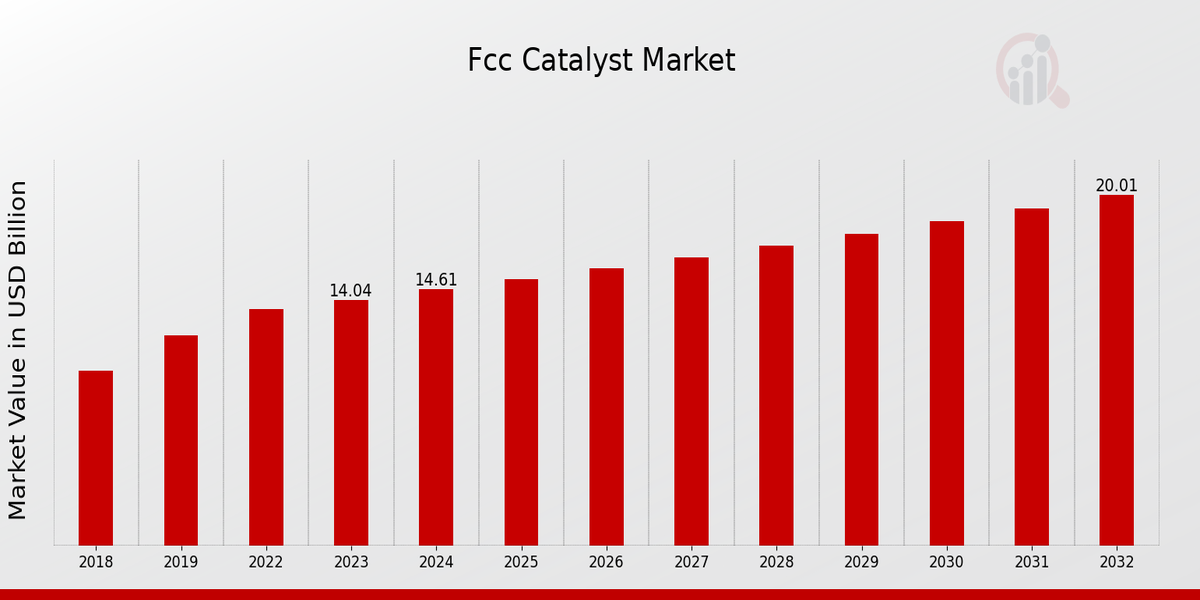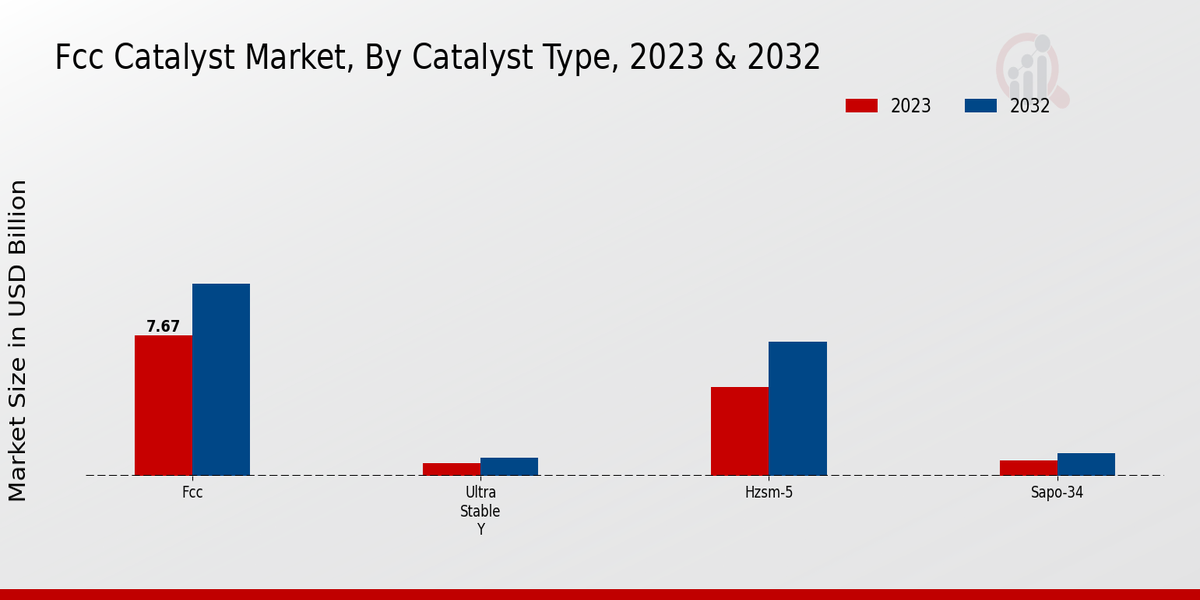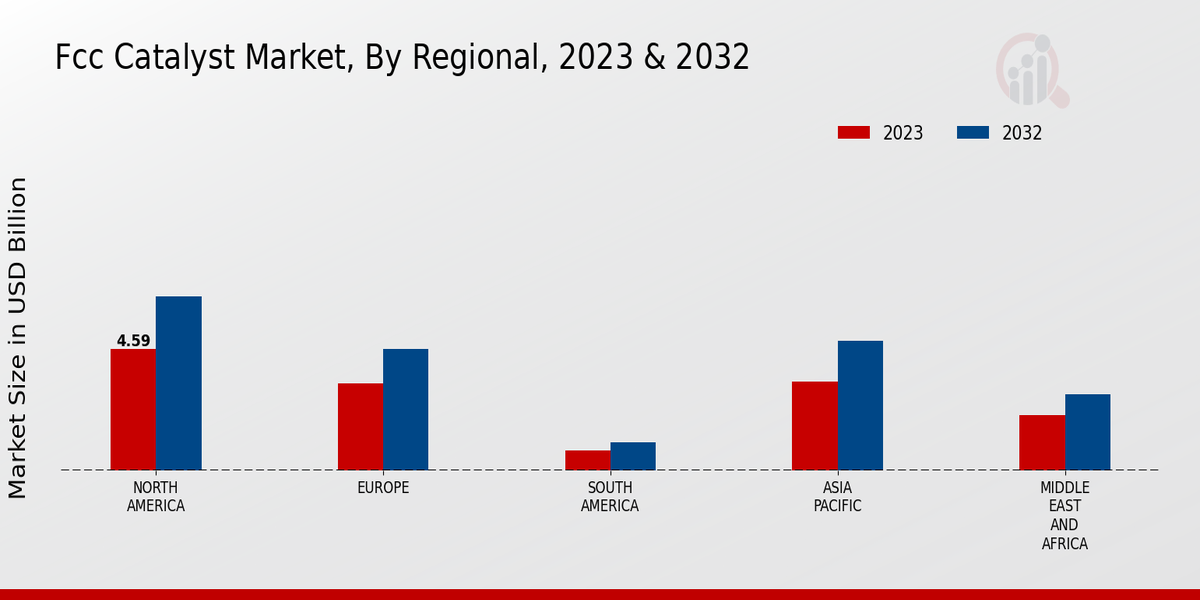Global FCC Catalyst Market Overview
The FCC Catalyst Market Size was estimated at 15.19(USD Billion) in 2024. The FCC Catalyst Industry is expected to grow from 15.8(USD Billion) in 2025 to 22.51(USD Billion) by 2034. The FCC Catalyst Market CAGR (growth rate) is expected to be around 4.00% during the forecast period (2025 - 2034).
Key FCC Catalyst Market Trends Highlighted
The FCC Catalyst market exhibits several key trends that shape its growth trajectory. One prominent trend is the increasing adoption of advanced FCC Catalysts with higher activity and selectivity, which enhance the efficiency of refining processes and optimize product yields.
Additionally, the growing demand for cleaner fuels has driven the development of environmentally friendly FCC Catalysts that minimize emissions and meet regulatory standards.
Opportunities abound in the FCC Catalyst market as the petrochemical industry continues to expand. The surge in demand for plastics and other petrochemicals creates a need for efficient and selective FCC Catalysts to optimize the production of these essential materials.
Moreover, the exploration of alternative feedstocks, such as bio-based materials, offers potential growth opportunities for FCC Catalysts tailored to specific feedstock characteristics.
In recent times, the FCC Catalyst market has witnessed a shift towards integrated catalyst solutions. Major players are increasingly providing comprehensive services that encompass catalyst manufacturing, application expertise, and technical support.
This trend reflects the need for refineries to maximize catalyst performance and minimize downtime, leading to a growing preference for turnkey solutions from trusted vendors.

Source: Primary Research, Secondary Research, MRFR Database and Analyst Review
FCC Catalyst Market Drivers
-
Increasing Demand for Refined Fuels
The primary driver of the FCC Catalyst Market is the increasing demand for refined fuels such as gasoline and diesel. The population is continuing to increase, and increasing demand for fuel is growing with the attendant need for transportation.
Hence, the FCC Catalyst Market is expected to rise further in the next few years. In addition, the refining sector is facing mounting pressure as the demand for refined fuels increases.
Many refineries worldwide are facing pressure to produce more fuel to meet the increasing market demand and at the same time need to operate within the prevailing stringent environmental regulations.
In the oil refining process, FCC Catalysts are essential because they help to convert heavier, low-value feedstock into lighter and more valuable products.
Growing Adoption of FCC Technology
At the first glance, the FCC technology is increasingly widespread among the refineries, the reason being the multiple advantages that it presents in comparison with other types of refining technologies.
Also, FCC Catalysts come to play a crucial role, supporting the transformation of the heavier, lower-value feedstocks into lighter and more valuable products.
As the number of refineries and other companies in the industry of refining is on the rise, it is expected that an increase in the FCC Catalyst Market.
Stringent Environmental Regulations
Stringent environmental regulations are also driving growth in the FCC Catalyst Market. These regulations are forcing refineries to reduce the emissions of harmful pollutants, such as sulfur dioxide and nitrogen oxides.
FCC Catalysts play a vital role in helping refineries meet these regulations, as they help to remove these pollutants from the refining process.
As a result, the increasing stringency of environmental regulations is expected to continue to drive growth in the FCC Catalyst Market in the coming years.
FCC Catalyst Market Segment Insights
FCC Catalyst Market Catalyst Type Insights
The FCC Catalyst Market is segmented by catalyst type into FCC, U l tra Stable Y, HZSM-5, SAPO-34, and Others. Among these, the FCC segment held the largest market share in 2023 and is projected to continue its dominance over the forecast period.
This is due to the high consumption of FCC Catalysts in the refining of heavy feedstocks, such as vacuum gas oil and residual oils.
The Ultra Stable Y segment is likely to grow at a considerable pace over the forecast period, thanks to its superior activity and selectivity in the conversion of heavy feedstocks.
Moreover, the demand for HZSM-5 catalysts is also on the rise as they offer the production of high-octane gasoline as well as the reduction of emissions. The market is driven by the expanding demand for refined petroleum products, particularly in emerging countries.
In addition, the demand for FCC Catalysts is poised to receive an impetus over the forecast period because of the tightening of environmental regulations vis--vis emissions and fuel quality.
The increasing demand for transportation fuels is another key driver for the market, along with the uptake of better refining technologies and the focus on environmentally sustainable products.
The prevalence of the use of bio-based feedstocks to manufacture fuels and chemicals is also anticipated to impact the growth of the market.

Source: Primary Research, Secondary Research, MRFR Database and Analyst Review
FCC Catalyst Market Application Insights
In 2023, the Methanol to Olefins MTO segment accounted for the largest share of the FCC Catalyst Market, and this trend is expected to continue throughout the forecast period. The Methanol to Gasoline MTG segment should be characterized by the highest growth rate during the forecast period.
In 2023, the Fluid Catalytic Cracking FCC segment was the most prominent type of application to occupy a sizeable share of the market, and it will maintain its leadership throughout the forecast period.
The Other segment, including such applications as Methanol to Aromatics MTA and others, will grow at a moderate pace at the same time.
FCC Catalyst Market Manufacturing Process Insights
The manufacturing process of FCC Catalysts is crucial in determining their performance and efficiency. Spray drying, extrusion, pelletizing, prilling, and other methods are commonly employed to produce FCC Catalysts. Spray drying involves atomizing a catalyst solution into droplets and drying them in a hot gas stream.
This method offers precise control over particle size and distribution, resulting in high catalyst activity and selectivity. Extrusion shapes the catalyst into specific forms, such as spheres or cylinders, ensuring uniform pore structure and mechanical strength.
Pelletizing involves compacting catalyst powder into pellets, which enhances handling and storage properties. Prilling creates spherical catalyst particles by dropping molten catalyst into a cooling tower, providing high surface area and improved mass transfer.
Other manufacturing techniques, such as freeze-drying and co-precipitation, are also employed to tailor catalyst properties for specific applications.
The choice of manufacturing process depends on factors such as catalyst composition, desired properties, and production scale, all of which influence the FCC Catalyst Market revenue, segmentation, data, statistics, and industry growth.
FCC Catalyst Market End Use Insights
The FCC Catalyst Market segmentation by End Use comprises of Refineries, Petrochemical Plants, Chemical Plants, and Others. Among these, Refineries segment held the dominant market share in 2023 and is expected to maintain its stronghold throughout the forecast period.
The increasing demand for transportation fuels and the growing refining capacity in emerging economies are major factors driving the growth of this segment.
The Petrochemical Plants segment is projected to witness significant growth in the coming years, owing to the rising demand for plastics and other petrochemical products.
Chemical Plants segment is also poised for steady growth, driven by the expanding chemical industry worldwide. The Others segment, which includes applications in various industries such as pharmaceuticals, food, and beverages, is expected to contribute to the overall growth of the market.
FCC Catalyst Market Regional Insights
The FCC Catalyst Market is segmented into North America, Europe, APAC, South America, and MEA. Among these regions, North America held the largest share of the market in 2023, and it is expected to continue its dominance during the forecast period.
The growth in this region can be attributed to the increasing demand for FCC Catalysts from the refining industry. Europe is another major market for FCC Catalysts, and it is expected to witness steady growth during the forecast period.
The APAC region is expected to exhibit the highest growth rate during the forecast period due to the increasing demand for FCC Catalysts from the refining industry in this region.
South America and MEA are relatively smaller markets for FCC Catalysts, but they are expected to witness moderate growth during the forecast period.

Source: Primary Research, Secondary Research, MRFR Database and Analyst Review
FCC Catalyst Market Key Players and Competitive Insights
Major players in the FCC Catalyst Market are constantly looking for new ways to improve their products and services. They are investing heavily in research and development to create innovative solutions that meet the needs of their customers.
This is leading to a highly competitive landscape, where companies are constantly vying for market share. Leading FCC Catalyst Market players are also expanding their reach by entering new markets and forming strategic partnerships.
This is helping them to increase their sales and profits. The FCC Catalyst Market is expected to continue to grow in the coming years, as the demand for these products increases. This growth is being driven by the increasing use of FCC Catalysts in the refining of crude oil and other petroleum products.
The competitive landscape of the FCC Catalyst Market is expected to remain highly competitive, with companies continuing to invest in research and development to create innovative products and services.
UOP, a leading company in the FCC Catalyst Market, develops and manufactures a wide range of FCC Catalysts that are used in the refining of crude oil and other petroleum products.
The company has a strong presence, with operations in over 50 countries. UOP is known for its expertise in catalyst development and its commitment to providing high-quality products and services to its customers.
The company has a strong track record of innovation, and it has developed a number of patented technologies that give it a competitive advantage in the market.
Honeywell is another leading competitor in the FCC Catalyst Market. The company develops and manufactures a wide range of catalysts that are used in the refining of crude oil and other petroleum products. Honeywell has a strong presence, with operations in over 100 countries.
The company is known for its expertise in catalysis and its commitment to providing high-quality products and services to its customers. Honeywell has a strong track record of innovation, and it has developed a few patented technologies that give it a competitive advantage in the market.
Key Companies in the FCC Catalyst Market Include
- Chevron
- KBR
- Shell
- Haldor Topsoe
- Albemarle
- BASF
- Axens
- ExxonMobil
- Sinopec
- R. Grace Con
- UOP Honeywell
- Clariant
- Honeywell
- Zeolyst International
- Johnson Mattheyn
FCC Catalyst Market Developments
The growing demand for cleaner transportation fuels, stringent environmental regulations, and rising investments in refinery infrastructure are key factors driving market growth. Asia-Pacific is anticipated to hold a significant market share due to increasing refining capacities and rising fuel consumption.
Major players in the market include BASF, Albemarle, Clariant, W. R. Grace Co., and Haldor Topse. Recent developments include the launch of new FCC Catalysts with enhanced activity and selectivity, strategic partnerships and acquisitions, and investments in research and development to improve catalyst performance.
FCC Catalyst Market Segmentation Insights
FCC Catalyst Market Catalyst Type Outlook
- FCC
- Ultra Stable Y
- HZSM-5
- SAPO-34
- Others
FCC Catalyst Market Application Outlook
- Methanol to Olefins (MTO)
- Methanol to Gasoline (MTG)
- Methanol to Aromatics (MTA)
- Fluid Catalytic Cracking (FCC)
- Others
FCC Catalyst Market Manufacturing Process Outlook
- Spray Drying
- Extrusion
- Pelletizing
- Prilling
- Others
FCC Catalyst Market End Use Outlook
- Refineries
- Petrochemical Plants
- Chemical Plants
- Others
FCC Catalyst Market Regional Outlook
- North America
- Europe
- South America
- Asia-Pacific
- Middle East and Africa
| Report Attribute/Metric |
Details |
| Market Size 2024 |
15.19(USD Billion) |
| Market Size 2025 |
15.8(USD Billion) |
| Market Size 2034 |
22.51(USD Billion) |
| Compound Annual Growth Rate (CAGR) |
4.00% (2025 - 2034) |
| Report Coverage |
Revenue Forecast, Competitive Landscape, Growth Factors, and Trends |
| Base Year |
2024 |
| Market Forecast Period |
2025 - 2034 |
| Historical Data |
2020 - 2024 |
| Market Forecast Units |
USD Billion |
| Key Companies Profiled |
Chevron, KBR, Shell, Haldor Topsoe, Albemarle, BASF, Axens, ExxonMobil, Sinopec, W. R. Grace Con, UOP Honeywell, Clariant, Honeywell, Zeolyst International, Johnson Mattheyn |
| Segments Covered |
Catalyst Type, Application, Manufacturing Process, End Use, Regional |
| Key Market Opportunities |
Advanced catalyst formulations for cleaner fuel production. The growing demand from emerging economies for improved FCC process efficiency. Strategic partnerships and collaborations. Integration of artificial intelligence AI |
| Key Market Dynamics |
The increasing demand for high-octane fuel, stringent emission regulations, the rising refinery capacity, technological advancements, and the growing demand in developing economies |
| Countries Covered |
North America, Europe, APAC, South America, MEA |
Frequently Asked Questions (FAQ) :
The FCC Catalyst Market is expected to reach a valuation of 15.8 billion USD by 2025 and is projected to register a CAGR of 4.00% to reach 22.51 billion USD by 2034.
The Asia-Pacific region is expected to hold the largest market share, followed by North America and Europe. The growth in the Asia-Pacific region is primarily attributed to the increasing demand for FCC Catalysts in the refining sector in countries such as China and India.
FCC Catalysts are primarily used in fluidized catalytic cracking (FCC) units in refineries. FCC units are used to convert heavy fractions of crude oil into lighter and more valuable products such as gasoline, diesel, and jet fuel.
Some of the key players in the FCC Catalyst Market include Albemarle Corporation, BASF SE, Clariant AG, ExxonMobil, and W. R. Grace Co.
The increasing demand for transportation fuels, stringent environmental regulations, and advancements in refining technologies are the major growth drivers of the FCC Catalyst Market.
The FCC Catalyst Market faces challenges such as the volatility of crude oil prices, the development of alternative refining technologies, and stringent environmental regulations.
The COVID-19 pandemic had a negative impact on the FCC Catalyst Market in 2020 due to the decline in demand for transportation fuels. However, the market is expected to recover in the coming years as the economy recovers.
The future of the FCC Catalyst Market is expected to be driven by the increasing demand for cleaner fuels, the development of more efficient refining technologies, and the adoption of sustainable practices.
The FCC Catalyst Market is subject to various environmental regulations, including those related to air pollution and waste management. These regulations vary by region and can impact the production and use of FCC Catalysts.
The FCC Catalyst Market offers investment opportunities in areas such as the development of more efficient and environmentally friendly catalysts, the optimization of refining processes, and the expansion of production capacity in emerging markets.

















